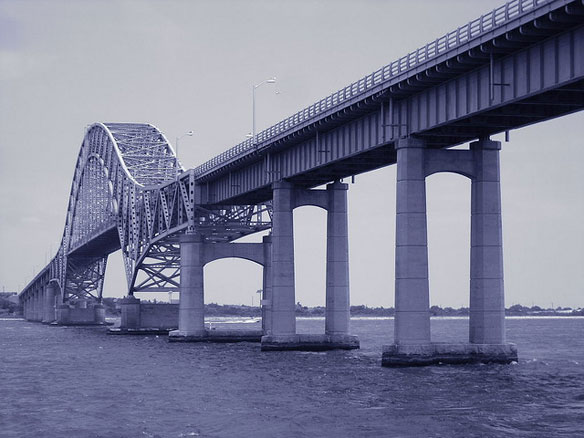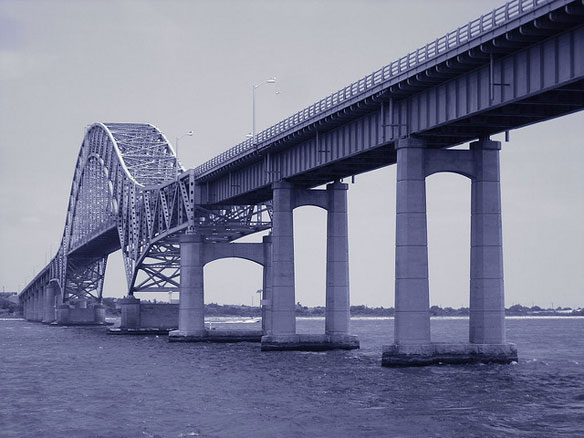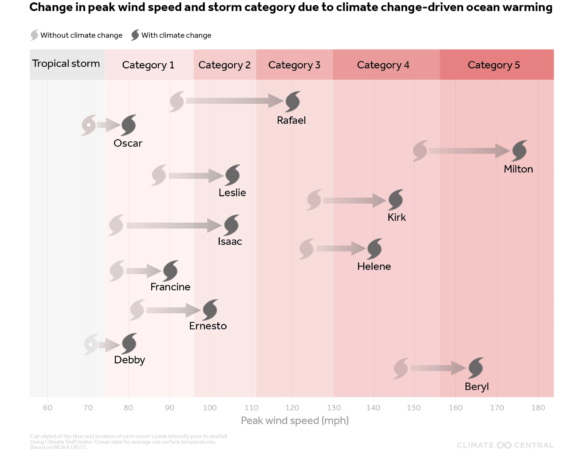
Great South Bay Bridge. Great South Bay is a lagoon situated between Long Island and Fire Island, in the State of New York. It is approximately 45 miles (72 km) long. It’s protected from the Atlantic Ocean by Fire Island, a barrier island, as well as the eastern end of Jones Beach Island and Captree Island. The rapid population growth around the shores of Great South Bay has led to numerous environmental problems. Wikipedia.Photo source: ©© Dougtone
By NOAA
NOAA has awarded $18,700 to State University of New York scientists to document the first known incidence of a bloom of harmful algae off Long Island’s south shore, study its effects on the area’s shellfish, and test a method that could control it.
The algae, Cochlodinium polykrikiodes, has been linked to the mass deaths of wild and farmed fish worldwide, with catastrophic effects on aquaculture and local economies. Experience with this type of algae elsewhere suggests that, once established, blooms are likely to re-occur.
This bloom, in the south shore’s Great South Bay, threatens a multi-million dollar shellfish restoration effort led by The Nature Conservancy (TNC). Since 2004, TNC has maintained shellfish sanctuaries in their 13,400-acre Great South Bay tract and conducted surveys to monitor planted shellfish, spawning success, and water quality.
The response, funded by NOAA’s National Centers for Coastal Ocean Science’s Harmful Algal Bloom Event Response Program, supports weekly research cruises to document the bloom’s size, extent, and toxicity. Additional studies will test the bloom effects on hard clams and benthic populations, and explore the feasibility of using clay to control future blooms.
Data from the NOAA-funded response will benefit TNC, county, state, and federal agencies, who all manage the Great South Bay shellfish restoration effort. Research will be carried out at the State University of New York‘s Stony Brook campus in Long Island, with research partners at the Nature Conservancy in Long Island.
“NOAA is committed to leading and developing our national capability to respond to harmful algal blooms and reduce their effect on public health, the economy and coastal resources,” said David Kennedy, assistant NOAA administrator for NOAA’s National Ocean Service. “This timely support from the National Centers for Coastal Ocean Science will allow local managers and scientists to assess and potentially mitigate this new threat to efforts to restore hard clams to Great South Bay.”
“Since blooms of Cochlodinium on eastern Long Island have lead to the death of caged fish and shellfish, the migration of these blooms into Great South Bay where The Nature Conservancy has been rebuilding hard clam populations is worrisome,” said Christopher J. Gobler, Ph.D., SUNY-Stony Brook and the project’s lead investigator. “We’re hopeful we can determine the precise effects of the blooms on these populations, as well as options for mitigating these blooms.”
“It is great that NOAA is able to mobilize so rapidly to assist with the characterization of this bloom and to help identify actions that are most likely to prevent these blooms in the future,” said Carl LoBue, senior marine scientist at The Nature Conservancy (TNC) and leader of its Great South Bay shellfish restoration efforts. An important TNC objective in Great South Bay is to position the estuary to be more resistant to harmful algal blooms.”









